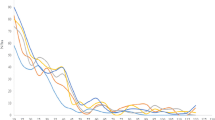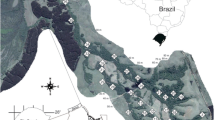Abstract
The structure and composition of riparian forests were examined along the Tokachi River, northern Japan. Both the hydrogeomorphic gradient and the temporal gradient were analyzed in attempt to explain the present pattern of riparian forests. The stability of floodplain surfaces was estimated on the basis of the elevation above the riverbed and the distance from the river channel. The characteristics of the substratum on which trees were established were also examined by excavation of buried sediment. The results indicated that soil moisture and organic content increased while the size of particles in the substratum decreased with increased elevation and distance from the river channel. Gradient analysis was employed to examine the distribution of dominant species, such as Alnus hirsuta, Toisusu urbaniana, Populus maximowiczii, Picea jezoensis and Abies sachalinensis. The relative dominance of each could be arrayed across the elevation gradient. Although the three broad-leaved pioneers dominated bars and floodplains near the river channel, their modes shifted from lower to higher elevation and amplitudes of distribution curves decreased in the following order: A. hirsuta, T. urbaniana, P. maximowiczii and conifers, which were located on the highest floodplains. Sites could be divided into three classes in terms of stability. There were fewer species at active sites, which favored the three pioneer species, but species richness and diversity increased with stand age. Semi-active and stable sites were more diverse with the establishment of conifers and other broad-leaved trees, which included upland species. However, species richness peaked and then decreased after trees reached 50 to 60 years of age. The growth of dwarf bamboo and the development of conifer-dominant stands impeded the establishment of other species, thereby reducing species richness and diversity in mature stands. Chronologically, floodplains could be differentiated into high- and low-frequency zones of flood disturbance, with pioneer species occupying the former, and late successional species found largely in the latter.
Similar content being viewed by others
References
Adams, D. E. & Anderson, R. C. 1980. Species response to a moisture gradient in central Illinois forests. Am. J. Bot. 67: 381-392.
Araya, T. 1971. Morphological study of bed load movement in torrential rivers. Res. Bull. College Exper. Forests, College of Agriculture, Hokkaido University 28: 193-258 (in Japanese with English abstract).
Aruga, M., Nakamura, F., Kikuchi, S. & Yajima, T. 1996. Characteristics of floodplain forests and their site conditions in comparison to toeslope forests in the Tokachi River. J. Jpn. For. Soc.: 354-362 (in Japanese with English abstract).
Bell, D. T. 1980. Gradient trends in the streamside forest of central Illinois. Bull. Torrey Bot. Club 107: 172-180.
Bell, D. T. & del Moral, R. 1977. Vegetation gradients in the streamside forest of Hickory Creek, Will County, Illinois. Bull. Torrey Bot. Club 104: 127-135.
Friedman, G. M. 1961. Distinction between dune, beach, and river sands from their textural characteristics. J. Sed. Petrol. 31: 514- 529.
Friedman, G. M. 1967. Dynamic process and statistical parameters compared for size frequency distribution of beach and river sands. J. Sed. Petrol. 37: 327-354.
Friedman, J. M., Osterkamp, W. R. & Lewis, Jr. W. M. 1996. The role of vegetation and bed-level fluctuations in the process of channel narrowing. Geomorphology 14: 341-351.
Hermy, M. & Stieperaere, H. 1981. An indirect gradient analysis of the ecological relationships between ancient and recent riverine woodlands to the south ofBruges (Flanders, Belgium). Vegetatio 44: 43-49.
Hupp, C. R. 1992. Riparian vegetation recovery patterns following stream channelization: a geomorphic perspective. Ecology 73: 1209-1226.
Hupp, C. R. & Osterkamp, W. R. 1985. Bottomland vegetation distribution along Passage Creek, Virginia, in relation to fluvial landforms. Ecology 66: 670-681.
Hupp, C. R. & Osterkamp, W. R. 1996. Riparian vegetation and fluvial geomorphic processes. Geomorphology 14: 277-295.
Ishikawa, S. 1988. Floodplain vegetation of the Ibi River in central Japan I. Distribution behavior and habitat conditions of the main species of the river bed vegetation developing on the alluvial fan. Jpn. J. Ecol. 38: 73-84 (in Japanese with English abstract).
Ishikawa, S. 1991. Floodplain vegetation of the Ibi River in central Japan II. Vegetation dynamics on the bars in the river course of the alluvial fan. Jpn. J. Ecol. 41: 31-43 (in Japanese with English abstract).
Johnson, W. C., Burgess, R. L. & Keammerer, W. R. 1976. Forest overstory vegetation and environment on the Missouri River floodplain in North Dakota. Ecol. Monog. 46: 59-84.
Kudo, H. 1980 The variation of floor plants after withering of Sasa Kurilensisby unusual mass flowering. J. Jpn. For. Soc. 62: 1–8.
Menges, E. S. & Waller, D. M. 1983. Plant strategies in relation to elevation and light in floodplain herbs. Am. Natur. 122: 454- 473.
Nakamura, F. 1995. Structure and function of riparian zone and implications for Japanese river management. Trans. Jpn. Geomorphol. Union 16: 237-256.
Nakamura, F. & Kikuchi, S. 1996. Some methodological developments in the analysis of sediment transport processes using age distribution of floodplain deposits. Geomorphology 16: 139- 145.
Niiyama, K. 1987. Distribution of Salicaceous species and soil texture of habitats along the Ishikari River. Jpn. J. Ecol. 37: 163-174 (in Japanese with English abstract).
Niiyama, K. 1989. Distribution of Chosenia Arbutifoliaand soil texture of habitats along the Satsunai River. Jpn. J. Ecol. 39: 173-182 (in Japanese with English abstract).
Nilsson, C. 1986. Changes in riparian plant community composition along two rivers in northern Sweden. Can. J. Bot. 64: 589-592.
Nilsson, C., Grelsson, G., Johansson, M. & Sperens, U. 1989. Patterns of plant species richness along riverbanks. Ecology 70: 77-84.
Nilsson, C., Ekblad, A., Gardfjell, M. & Carlberg, B. 1991. Long-term effects of river regulation on river margin vegetation. J. Appl. Ecol. 28: 963-987.
Ohwi, J. and Kitagawa, M. 1983. New Flora of Japan. Shibundo, Tokyo, 716 pp.
Pielou, E. C. 1974. Population and Community Ecology: Principle and Method. Gordon & Breach Science Publication. 424 pp.
Scott, M. L., Friedman, J. M. & Auble, G. T. 1996. Fluvial process and the establishment of bottomland trees. Geomorphology 14: 327-339.
Shibakusa, Y., Takahashi, K. & Saito, Y. 1968. Natural regeneration of Abies sachalinensisand its environmental factors with special reference to relative light intensity. Proceeding of the 79th Annual Conference of Japanese Forestry Society, pp. 293-295 (in Japanese).
Sigafoos, R. S. 1964. Botanical evidence of floods and flood-plain deposition. United State Geological Survey Professional Paper 485-A: A1-A35.
Author information
Authors and Affiliations
Rights and permissions
About this article
Cite this article
Nakamura, F., Yajima, T. & Kikuchi, Si. Structure and composition of riparian forests with special reference to geomorphic site conditions along the Tokachi River, northern Japan. Plant Ecology 133, 209–219 (1997). https://doi.org/10.1023/A:1009787614455
Issue Date:
DOI: https://doi.org/10.1023/A:1009787614455




